Good Hoof Care Will Save You Money
December 1, 2009Good Hoof Care will Save You Money
An old adage, “Shoeing is a necessary evil,” has been prevalent throughout the history of horse owners. Though this aged saying has been accepted at face value for decades, closer assessment will disclose the error in this line of thought. Shoeing is not always necessary; neither is it always evil. Multiple factors with the help of an accredited professional will determine if, why and how a horse should be shod. Some of these factors are (1) the proposed use of the horse, (2) the condition of the feet and legs, (3) the tasks to be performed, (4) the environment in which the horse is to perform, and (5) the surface upon which the horse will be working.
Another adage frequently heard is “No hoof, no horse.” This is as true today as when the expression was first coined. Good hoof care is good economy and there is no substitute but there are economical products from Durvet to make your job easy; www.Durvet.com .
It’s best to have your horse trimmed or shod every four to eight weeks, in addition to picking your horse’s hooves daily to remove dirt and debris. Feed your horse a biotin supplement like Biotin DAILY by Durvet to promote healthy hoof growth. Keep your horse away from wet footing or bedding to prevent soft hooves and thrush, a stinky fungus that eats away at the frog and sole of the hoof. A good and economical treatment for thrush is D-ThrushT, another competitively priced product offered by Durvet and available at most farm, feed and tack stores. Another tip to keep in mind is that dry hooves may be caused by a lack of exercise and allowing your horse to stand in mud can damage their hooves and legs so keep up an adequate exercise program and good stable management practices.
What is Thrush? It is a common ailment of horses’ hooves (frog degeneration) caused by a secondary anaerobic bacterial infection. What are the most notable signs of thrush? A very offensive odor may radiate from the underside of the hooves, a very dark, thick, liquid may be discharged from the hooves and possible lameness may occur in severe cases. What are the causes of thrush? Poor management practices, wet conditions and failure to clean hooves regularly are major causes. How is thrush treated? After thoroughly removing debris and necrotic material from the infected hoof, apply a Copper Naphthenate product, such as D-ThrushT (an economical equivalent to KopertoxR -a registered trade mark of Ft Dodge) as directed on the label to the affected area. Repeat daily. How can thrush be prevented? Provide dry, clean standing areas free of urine-soaked bedding and manure, regular exercise, and good farrier care will also help prevent this disease.

